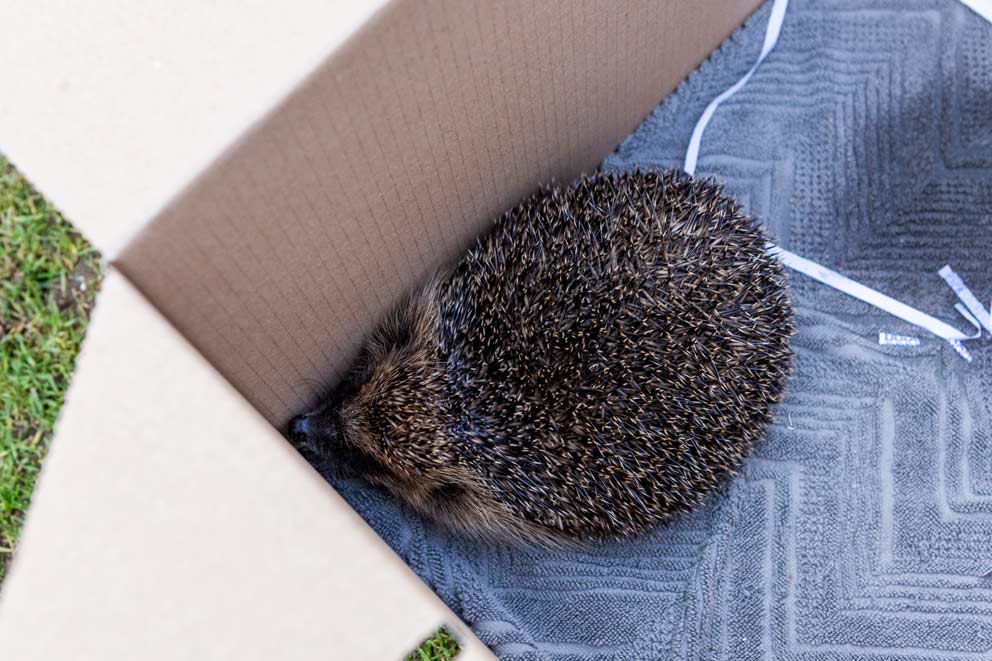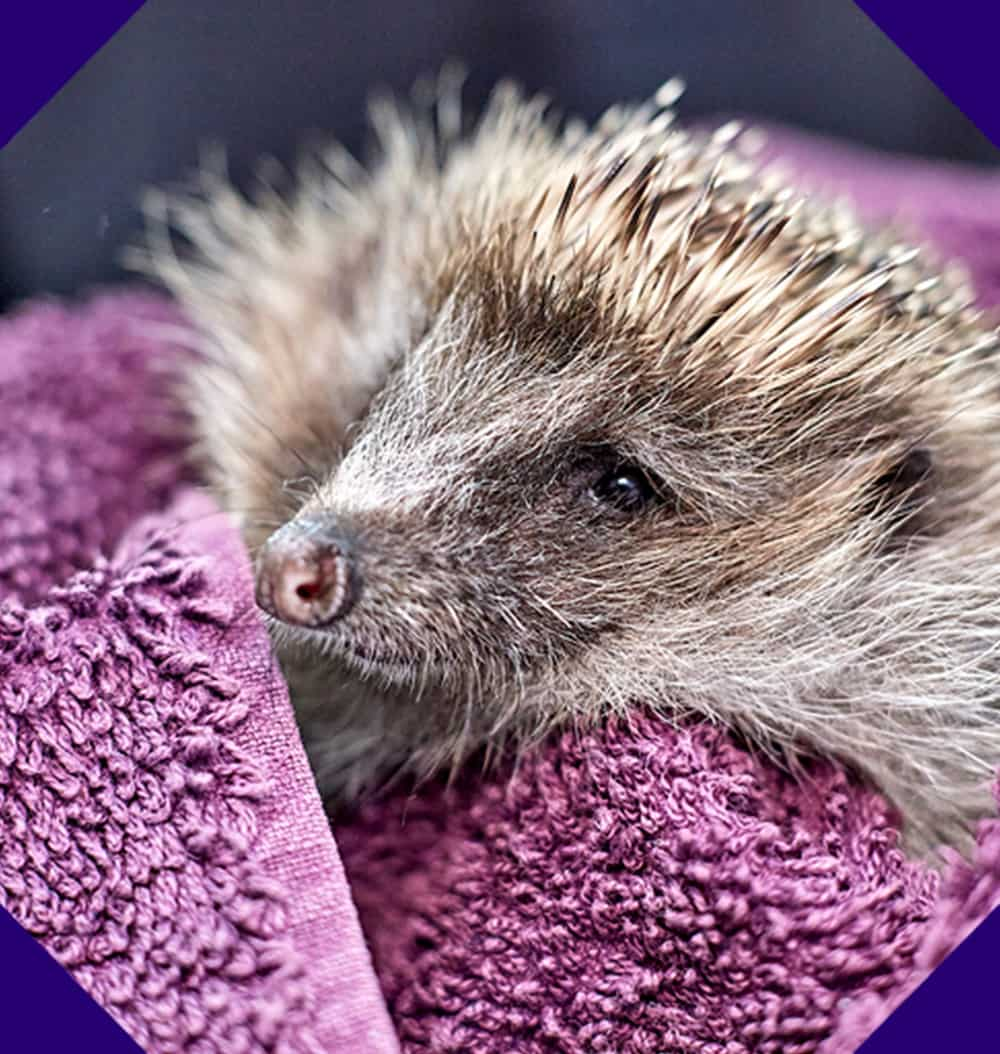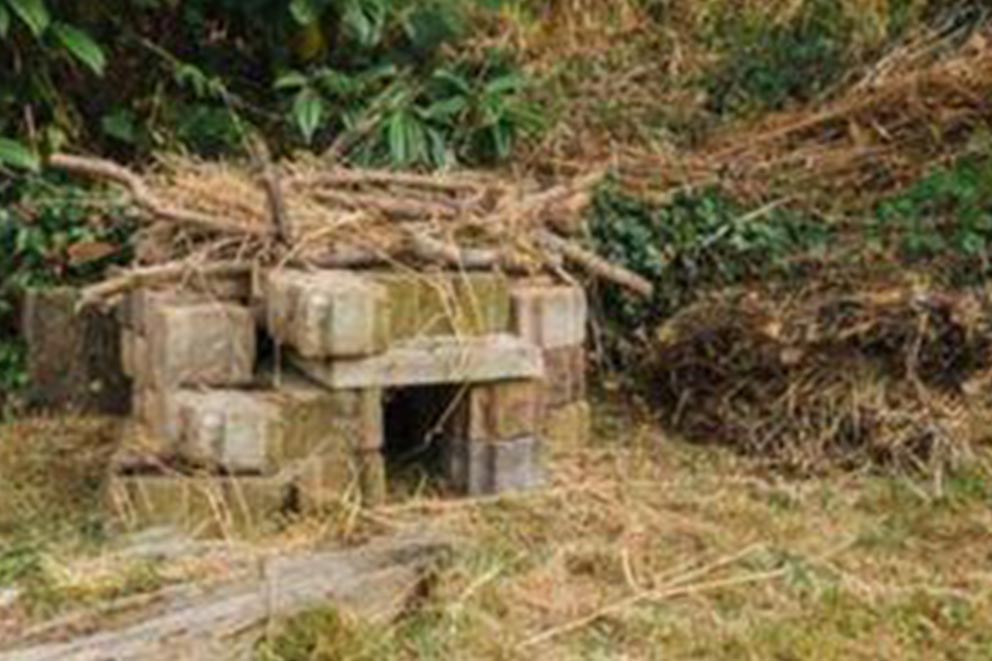Build a hedgehog-friendly bonfire
Learn how to build a bonfire that puts the welfare of wildlife, like hedgehogs, first. On this page, we’ll show you the best ways to ensure no wild animals have made a home inside your bonfire before lighting – and what to do if they have.
- Suitable for: Adults only!
- Season: Autumn/Winter

Autumn brings with it the arrival of Bonfire Night for us, and hibernation for some wild animals. Unfortunately, our celebrations can have severe consequences on their welfare.
Wildlife like hedgehogs, dormice, frogs, toads, and a variety of insects often seek shelter in the piles of natural materials that are used to build bonfires – and end up killed or seriously injured when these bonfires are lit.
However, it’s not just in autumn that bonfires put wildlife at risk; whether you’re burning garden prunings or building a campfire, wildlife can pay the price.
Hedgehogs, in particular, are one of the most at risk animals when it comes to bonfires. But you can change that. Help us protect hedgehogs and other wildlife this season, by building a bonfire that is safe, wildlife-friendly and hedgehog-free.
jump to
Spotted an injured hedgehog?
The best way to protect hedgehogs and other wildlife is to check before you start building your dead hedge, as hedgehogs could be nesting or hiding in piles of leaves or sticks. If you find an injured hedgehog, take it to your nearest vet.
How to make sure your bonfire is
hedgehog-friendly
Instructions
-
1
Build your bonfire on the day: The best way to stop hedgehogs and other wildlife from getting into your bonfire is to build it on the day you’re lighting it.
To wildlife like hedgehogs, a bonfire built days in advance is just a pile of logs they can use as a place to nest, or hibernate. The longer your bonfire is sitting there, the more likely a hedgehog will find its way inside.
When selecting where to build the bonfire, choose ground that’s clear of leaves or pampas grass, as these are common locations for hedgehogs to nest.
On the day of lighting, move the materials from where they’ve been kept (beside the bonfire site or in storage, for example) before building it, to ensure the site is clear beneath them.
-
2
Check the bonfire before lighting: Before lighting, use a broom handle, a pole or something similar to lift sections of the bonfire to check for any hedgehogs that might be nestled inside. DON’T use a fork, rake or anything pronged, as this might harm the wildlife.
Make sure to check the entire bonfire thoroughly, as hedgehogs frequently hide in the centre and the bottom two feet of the bonfire. Distressed or disturbed hedgehogs often make a hissing noise, so listen out as you search. Take your time and be gentle, using a torch to aid you as you look and listen out for signs of hedgehogs. -
3
Light the bonfire from one side only: Remove the chicken wire, then light the bonfire from one side or corner, rather than from the middle. If there is a hedgehog or other wildlife inside that you happened to miss, this will give it one final chance to escape out of the unlit side.
However, if you do need to build your bonfire in advance, you should: Check there are no animals trapped inside, then wrap the bottom of the bonfire with one metre high chicken wire, held in place with stakes. Position the wire at an angle, sloping against the bonfire – this makes it difficult to climb and helps to prevent hedgehogs from getting in.
The most thorough way to check there’s no wildlife in your bonfire is by moving the entire bonfire by hand again, immediately before lighting.
What you'll need
Bonfire materials (tinder, kindling, fuel, etc)
One metre high chicken wire
Several stakes (to hold the chicken wire in place)
A broom, pole or something similar
A torch
Gardening gloves or an old towel
A large box (with lid and air holes) or cat carrier
Torn up newspaper, shredded paper, towel, leaves or straw
Meaty cat or dog food
What to do if you find a hedgehog in the
bonfire
Instructions
-
1
Gather up the hedgehog: Grab a pair of gardening gloves (or use an old towel), and gather up the hedgehog with as much of its nest material as you can.
If the bonfire is taking place during the spring/summer, there’s a chance there may also be babies in there, too. If so, make sure to gather them all.
Handling a creature as small and timid as a hedgehog might seem daunting at first, but treating them with care is easier than you might think. You are more than capable of helping a distressed, trapped or injured animal, and doing so might just save their life. -
2
Place the hedgehog in a large box: Find a large box or a cat carrier to gently place the hedgehog into, filled with torn up newspaper, shredded paper, towel, leaves or straw. If there are hoglets present as well, place all the hedgehogs into the same box so you don’t separate the family.
Leave a bowl of water and meaty cat or dog food inside the box. Ensure there are enough air holes in the box before securing the lid in place to keep them in. -
3
Move the hedgehog to somewhere safe: Find a safe and quiet location, like a shed or garage, away from the bonfire and other festivities (such as fireworks). If you can, put out the bonfire, then dampen down the site with water to ensure it can’t reignite (if you can’t, then wait until the bonfire has finished, and do the same).
-
4
Release the hedgehog under a hedge: Once the bonfire is completely dampened, release the hedgehog under a hedge or bush, or by a log pile (that won’t to be used for another bonfire), near to where you originally found it.
To do this, slowly turn the box onto its side, or remove the cat carrier door, and let the hedgehog wander out in its own time. Make sure you return the hedgehog along with the nesting material you found it with.
If you’ve found a hedgehog inside your unlit bonfire, the first thing to do is remain calm and move slowly, so you don’t alarm it. Then:
Did you know? Hedgehogs are the escape artists of the wildlife world; they are incredible climbers and scramblers.
Watch our video for more advice on how to rescue and transport hedgehogs and other small mammal wildlife.
Wild animals can sustain terrible burns or even die in bonfires so it’s really important people check carefully before lighting them. Piles of leaves or wood are attractive nesting places for many wild animals, especially hedgehogs. So ideally, a bonfire should only be built on the day it is going to be lit, to reduce the possibility of an animal hiding inside it.
What to do if you find an injured hedgehog
If you find a hedgehog that is visibly hurt, or you spot signs that it might be sick or injured, then there are ways you can help.
What to do if you find a dead hedgehog
It can be heartbreaking to find a hedgehog it’s too late to save. But there are still ways you can help:
Report it to the Garden Wildlife Health project, who use this information to help safeguard wildlife in the future.
If you find a dead hedgehog during breeding season (from mid-April to September), watch out for any orphaned hoglets nearby. Any baby hedgehogs you find with the dead mother hedgehog will need urgent care and should be taken to a vet or wildlife rehabilitator as soon as possible. Learn what to do if you find orphaned hedgehogs with our advice.

More ways you can help
hedgehogs and other wildlife
Bonfire Night marks the time of year when hedgehogs head into hibernation, which is a vital part of their survival.
There are many ways you can help them prepare, supplementing their diet and providing suitable shelter for them to sleep through the winter:
- Buy or build a hedgehog house
- Leave out clean water
- Buy specialist hedgehog food or give them meaty cat or dog food
- Create ‘wild areas’ in the garden such as leaf piles and log piles
- Cover drains and holes
- If you have a pond or pool, make sure there’s an accessible escape route if a hedgehog happens to fall in
- Buy or create a hedgehog highway




